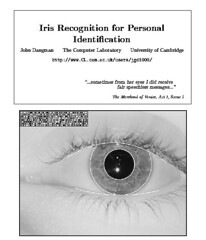
iris id
When I first wrote about names, identities and signatures in online communication (here), I knew that there was very little work in the area. Turkle’s seminal work Life on the Screen (1995) was already a bit dated and David Crystal’s Language and the Internet (2001) had not yet been published. However, I wasn’t fully aware of the enormity of the topic at the time.
Not only are we seeing wide spread use of personalised screen signatures (in email, i-m and message board environments) but our access to geographical and informational spaces is increasingly policed by individual codes, passwords and pin numbers. In the UK, the introduction of ‘chip-and-pin’ payment methods effectively banishes traditional signatures from most financial transactions. Our mark becomes a sequence of digits.
New methods of identification are accompanied by new possibilities for identity theft. Now it seems that with iris recognition (patented in 1994) and the more recent vein identification, technology may deliver more reliable systems of tagging individuals. Will signatures eventually become obsolete, I wonder?
I have a friend who spent some time working on an IT project to replace passwords with a facial recognition system. You had to remember four faces from a random display and that was your password. I found it much harder to remember faces than words.. the iris recognition approach, of course, is the opposite- it recognises your face instead of you recognising it.. but still feels weird. If they could come up with a system like this that meant I didn't have to sign a million bits of paper a week, though, that would be cool.
ReplyDeleteI say a little rhyme to help me remember my PIN. I ca only deal in words and can recall twelve words easier than four numbersThe rhyme is about my Dad!!! So I guess you could say I was going through a little identity performance.
ReplyDelete